As Boards scan the strategic horizon there are plenty of threats and dilemmas to be faced. The likelihood of one crisis or another impacting on the business is high, with threats from: pandemics, wars, financial crisis, environmental crisis, political turmoil and technological disruption.
Boards need to continue to think long and hard about how they can ensure that their businesses are resilient and responsive.
How can a Board respond to these challenges? Critically before starting to dapple with the business, some self-reflection may be necessary, evaluating what shape the Board is in to face the future. A number of key areas for evaluation on ‘fit for purpose’ are.
Active Strategic Strengths Plan. How well developed is the strategic plan and has there been a robust strengths analysis of the business.
Current and Future Capabilities. How well mapped are the Board’s current and future capabilities? Do we have a relevant and diverse set of knowledge, experiences and expertise to meet these strategic challenges?
Sponsorship of Innovation and Creativity. How well as a Board are we actively fostering a culture of innovation and creativity in the business? What programmes are we pro-actively sponsoring and monitoring?
Open Communication and Collaboration: How effectively do we encourage open communication and collaboration among board members and with the Executive?
Trends and Impacts. How well do we stay informed about industry trends and emerging technologies which may impact on the business?
The Board should have its own action plan to rectify any gaps they identify in their armoury by engaging with key elements of the strategic plan and ensuring there is an informed and pro-active Board succession plan which maps to the strategic plan. To support its own plan the Board should sponsor and monitor active engagement between all the Board Members and the Executive team to leverage Board expertise as appropriate.
The Board should also have a visible, open and active network outreach engagement to monitor trends and technologies facing the industry. A well-functioning Board will be fully engaged with emerging trends. They will work together with their executive and jointly gain insights beyond the immediate business pressures, to become insightful and informed about the future waves of change. For example, the Boards should take a more engaged and informed stance applying their experience perspective and wisdom, beyond the existing digital landscape, to support the executive in exploring both AI opportunities and implications and the uncharted horizons of Quantum computing. My memory and experience of coaching senior Directors and Executives during the first Dot.com boom serves me well to bring some perspective and context to the challenges of a transformational landscape, to consider the opportunities beyond ‘we are all doomed’.
As these structural Board challenges are addressed the Board can start to take a wider perspective on how to effectively support a sustainable resilient business into the future.
A sustainable resilient business requires a longer-term perspective than the average tenure of a CEO at around five and half years. A great Board will create a culture, processes and programmes which survive beyond the CEO tenure and their own Board memory of 16 years. This will manifest itself in a Board monitored development programme for the Leadership cadre which actively supports a culture of innovation and renewal.
Our dynamic and adept Board of Directors will be leaders who oversee the governance and strategic direction of an organisation in a flexible, transparent and adaptive way. Some of the characteristics of this sustainable landscape are described below.
A transformational outlook from the Board, which recognises and encourages the need for change and innovation as a source of value creation. A culture where the customer and stakeholder are at the centre of the business deliberations with the Board and business responding to their evolving needs and expectations. A Board which nurtures a culture of trust and collaboration recognising the challenge is to capture and leverage the ideas and innovation already existing throughout the business.
The dynamic Board will also be monitoring progress to ensure that their sustainable future goes beyond wise words and progresses into the fabric of the organisation into its culture, project and programmes. Finally, our adept Board will balance dynamism and stability with clear values and principles, being open to new opportunities and challenges, without bending to every latest trend and fashion, but extracting the meaningful trends underlying a shift in their business environment.
It is easy enough to outline and subscribe to these underpinning principles and approaches to building a resilient and innovative organisation. Much harder to get them off the paper and into the living fabric of the business. It is only with a Board which takes a good hard look at itself to ensure it is itself living these values that the longevity and sustainability of a responsive and resilient business can be successfully developed.



